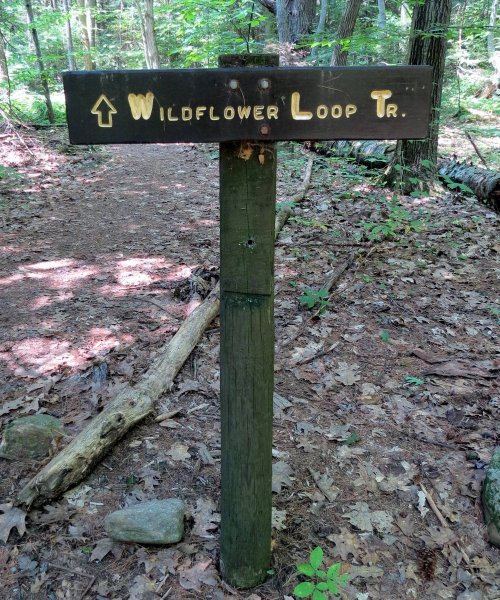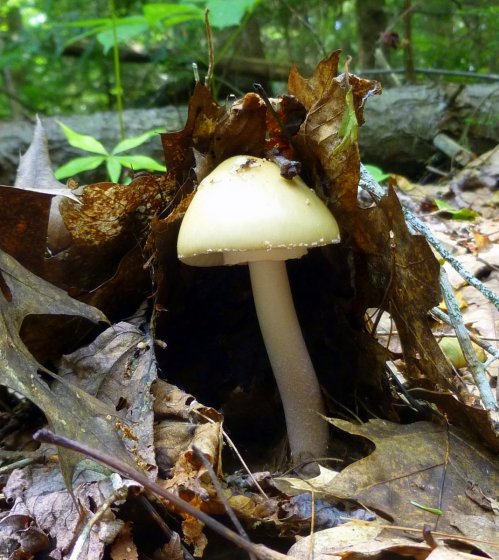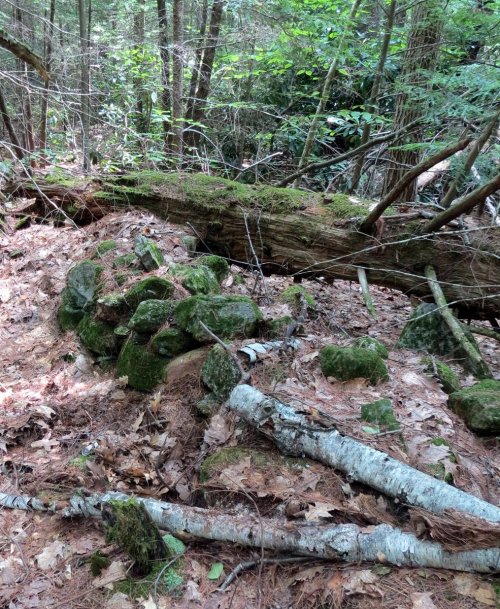It takes about a half hour to get there from my house but the trip to Rhododendron State Park in Fitzwilliam, New Hampshire is always worth the effort and is a trip I try to make at least once each week at this time of year. It’s out in the middle of nowhere and is one of those places that approaches what the true wilderness must have looked like before European settlers arrived.
This park is a true botanical park and the only one of its kind in the state. People from all over the world come here to see the native rhododendrons (Rhododendron maxima) that grow here. The park contains the largest grove of these rhododendrons known to exist in New England. Common in south eastern states, they have reached the northernmost point of their growth here. The park was designated a national Landmark in 1982.
Paths are wide and level in most areas. They are also shaded for the most part, and lined with marginal wood fern (Dryopteris marginalis) and many other plants.
Signs clearly mark the trails. I took a photo of this one because I come here for the wildflowers rather than the rhodies. Most wildflowers that grow here are quite common and what you would expect to find in New England. Partridgeberry, teaberry, wild sarsaparilla, bunchberry, blue bead lily, pink lady’s slipper, painted trillium and many others too numerous to list grow here. There are other orchids besides lady’s slippers, but they are very hard to find.
This native rhododendron isn’t like others-it blooms in mid-July rather than in spring. The land that they grow on is low and often quite wet and I think that’s why they have been left alone since Captain Samuel Patch settled here in 1788. The higher surrounding land was farmed but not where the rhodies grew. In 1901 a subsequent owner almost had the land logged off for timber but instead it was bought and given to the Appalachian Mountain Club with the stipulation that it be protected and open to the public forever after.
The National Park Service calls them pink, but I see white when I look at the blossoms. Though most of these plants are quite tall it is still easy to get close to the blossoms.
The trunks of the shrubs grow in impenetrable thickets in places, and are so tall that you walk through “rhododendron tunnels” as you follow the pathways.
With all of the large leaves of the rhododendrons overhead reaching for the sun it can be quite dark in some areas. That is why this park is also one of my favorite mushroom hunting places.
You know there isn’t much sunlight reaching the ground when you see slime molds. Sunlight is their number one enemy.
Some of the most interesting things here are small and hard to see. I’ve seen people walking the paths quickly as if they were in a hurry to be out of the park, and I often wonder how much they might have missed. This is the kind of place where you need to walk very slowly while scanning the woods along the sides of the path if you are to see very many wildflowers. I just found an orchid growing right beside the path that I must have walked by at least 20 times last year without seeing. It’s a small thing that isn’t blooming yet, so it doesn’t appear in this post. I’ve also found other plants here that I haven’t ever seen anywhere else.
What makes this place so special for someone like me is how the land has gone virtually untouched by man since at least 1901 because there are certain plants that absolutely refuse to grow in anything but old, undisturbed soil. Unless a tree falls across a trail nature is allowed free reign here. As you can see in the photo a tree fell on a stone wall a long, long time ago and was left where it fell. This kind of hands off approach is important to many species of plants, and you really never know what you’ll find here.
Seeing pipsissewa (Chimaphila umbellate) growing in sunny spots was one of the clues that I might see something even more special. I’ve noticed that this is a plant that prefers growing in undisturbed soil.
Only another plant hunter will understand how my pulse quickened when I saw this striped wintergreen (Chimaphila maculate) with flower buds. This plant is rare in all of New England but seems especially so in this corner of New Hampshire. I know of only two small plants and I’ve never seen them bloom until now. Someone from Connecticut wrote to tell me that they knew of a few colonies there on undisturbed land and I have also heard of isolated colonies in New York where it is listed as exploitably vulnerable, meaning when people see it they pick it or dig it up. The plant grows as far west as Illinois, but it is endangered there and also in Maine.
If you happen to see this plant please do not dig it up or pick the flowers! It will not grow in your garden, so leave it in the forest for the rest of us to enjoy.
There is a fairly good chance that if you live in New England, you have never seen this flower. This was my first ever glimpse of it and I was surprised to see how much the blossom looked like that of pipsissewa. I shouldn’t have been though, because both plants are native wintergreens. If you’d like to see the pipsissewa blossom just click here.
I hope the small flies that are on the blossoms are pollinators so the plants will set seed.
Included in the park is the center chimney cape that Captain Samuel Patch built with his son sometime before he died in 1817. Captain Patch served in the Revolutionary war and took part in the battle of Bunker Hill and, though his house has changed hands a few times since being built, it looks to be true to its original footprint.
The house is closed to the public but what I like most about it is its old gardens that contain some very old plants like valerian and wood betony. This is also the location of the only moth mullein plant that I know of.
If you’d like to read more about the park just click here. I’ll be going back there today hoping to find an orchid finally blooming. I’ve been waiting for 6 weeks to see its flower.
The forest is a peculiar organism of unlimited kindness and benevolence that makes no demands for its sustenance and extends generously the products of its life activity; it provides protection to all beings, offering shade even to the axeman who destroys it. ~ Gautama Buddha
Thanks for stopping in.















